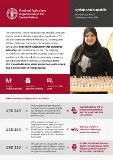Publications

Cameroon: Project Highlights - OSRO/CMR/200/JPN
04/2024
The Government of Japan contributed USD 226 000 to FAO's project entiteld "Supporting resilient food security and protection-sensitive livelihoods strategies in Far North Cameroon".
.tmb-th600x450.jpg?Culture=en&sfvrsn=f5d3a839_6)
Northeastern Nigeria: Humanitarian Response Plan 2024
04/2024
In 2023, the levels of acute food insecurity in northeastern Nigeria were comparable to those reported during the peak of the crisis in 2016/17.

Resilience building in Somalia: FAO Programme Review 2024
04/2024
Leveraging on more than a decade of delivering humanitarian response, saving lives, and building resilient and sustainable livelihoods in Somalia, FAO continues to prioritize strengthening the productive sectors and resilient food systems.

Cameroon: Belgium's contribution through the Special Fund for Emergency and Rehabilitation Activities (SFERA)
04/2024
Cameroon, as most countries in the Sahel, is currently facing shocks that are affecting people’s food security and livelihoods.

Resilience Building in South Sudan: FAO Programme Review 2024
04/2024
The FAO Regional Office for Africa (RAF) collaborates with several African countries in Sub-Saharan Africa, including South Sudan, to enhance resilience building efforts.

Resilience building in Liberia: FAO Programme Review 2024
04/2024
The FAO Regional Office for Africa (RAF) collaborates with several African countries in Sub-Saharan Africa, including Liberia, to enhance resilience building efforts.

Resilience building in Zimbabwe: FAO Programme Review 2024
04/2024
FAO Zimbabwe is implementing diverse initiatives across the agriculture sector as a contribution to FAO’s Resilience Strategy Southern Africa.

Resilience building in Ethiopia: FAO Programme Review 2024
04/2024
Under the resilience building programme, Ethiopia is a focus country for the regional initiative on Building Resilience in Africa’s Dry lands.

Yemen: Project Highlights - OSRO/YEM/205/USA
04/2024
The Government of the United States of America contributed USD 1.6 million to the Food and Agriculture Organization of the United Nations to improve food availability and access for the most vulnerable households in Yemen by strengthening the capacity of the Food Security and Agriculture Cluster.

Haiti: Executive brief of the DIEM-Monitoring assessment, round 5 (January 2024)
04/2024
The Food and Agriculture Organization of the United Nations’ Data in Emergencies (DIEM) has launched an Executive brief series.

Burkina Faso: Humanitarian Response Plan 2024
03/2024
In Burkina Faso, insecurity continues to spread across the country, making it increasingly difficult for vulnerable populations to access humanitarian assistance.

Cameroon: Humanitarian Response Plan 2024
03/2024
Cameroon faces a multifaceted crisis due to the conflict in the Lake Chad Basin and Far North, the influx of refugees from the Central African Republic, ongoing tensions in the North-West and South-West regions, and the impact of natural hazards.

South Sudan: DIEM – Data in Emergencies Monitoring brief, round 4
03/2024
This Data in Emergencies Monitoring (DIEM-Monitoring) brief shares the results of a fourth-round assessment conducted from July to September 2023 in South Sudan.

Democratic Republic of the Congo: Humanitarian Response Plan 2024
03/2024
The Democratic Republic of the Congo is one of Africa’s largest internal displacement crises, with 22 percent of the population acutely food insecure due to increased armed conflict and the impact of climate hazards.

South Sudan: Contributions to mitigating conflict between mobile pastoral communities
03/2024
This learning brief documents the main lessons drawn from the South Sudan country investment project entitled Resilient Pastoral Livelihoods and Education implemented by the Food and Agriculture Organization of the United Nations and its partners.

South Sudan: Humanitarian Needs and Response Plan 2024
03/2024
Humanitarian needs in South Sudan are expected to reach a record high this year. Amid a complex emergency that has displaced millions and destroyed livelihoods, more than half the population will be acutely food insecure during the lean season from April to June.

Syrian Arab Republic: Humanitarian Needs and Response Plan 2024
03/2024
Thirteen years of conflict and an enduring economic crisis in the Syrian Arab Republic continue to drive humanitarian needs, disrupt agriculture and weaken the country’s food production capacity.

Nigeria: DIEM – Data in Emergencies Monitoring brief, round 6
03/2024
This Data in Emergencies Monitoring (DIEM-Monitoring) brief shares the results of a sixth-round assessment conducted in January and February 2024 in Nigeria.

Mozambique: Humanitarian Needs and Response Plan 2024
03/2024
Mozambique is one of Africa’s most climate-vulnerable countries. In addition to climate shocks, the ongoing conflict in Cabo Delgado is the country’s main driver of food insecurity.

Central African Republic: Humanitarian Response Plan 2024
03/2024
The Central African Republic is one of the world’s ten poorest countries, with around 7 in 10 Central Africans living below the poverty line on less than USD 2.15 per day.
